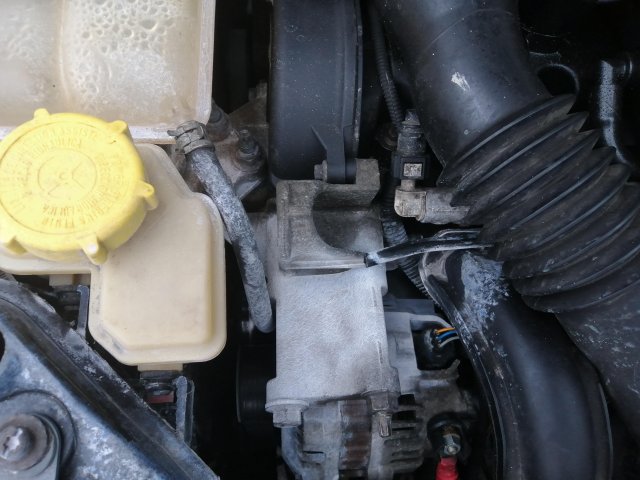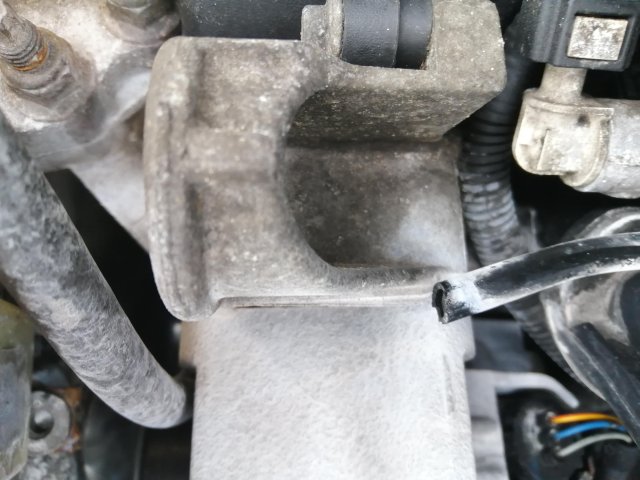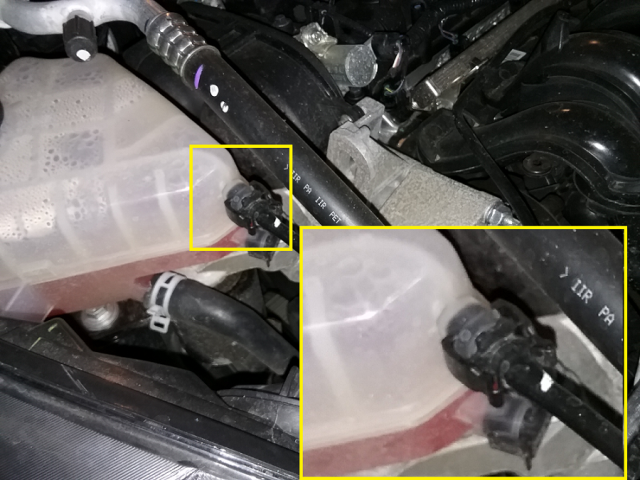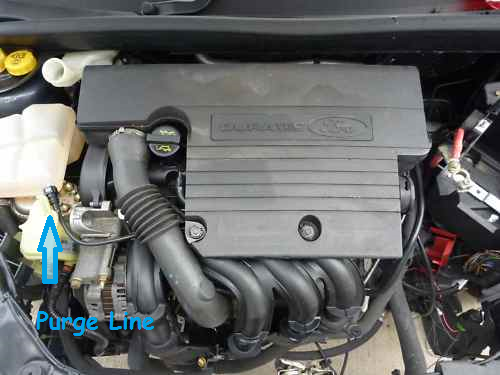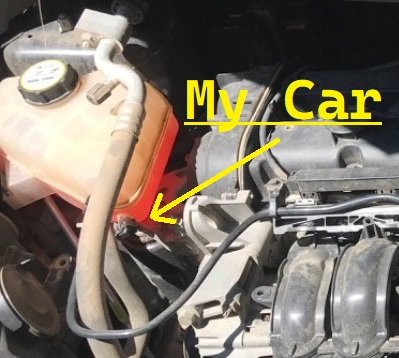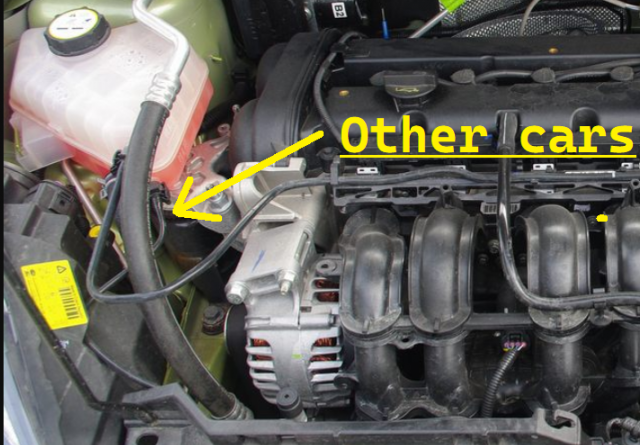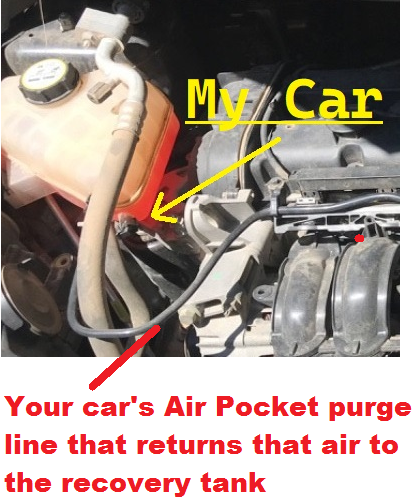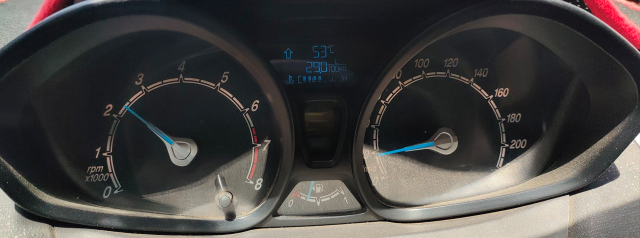-
Sign Up! To view all forums and unlock additional cool features
Welcome to the #1 Ford Fiesta Forum and Ford Fiesta community dedicated to Ford Fiesta owners and enthusiasts. Register for an account, it's free and it's easy, so don't hesitate to join the Ford Fiesta Forum today!
Detached water pipe
- Thread starter Markren
- Start date
- Messages
- 1,986
- Likes
- 1,385
- City
- Grand Rapids
- State
- MI
- Country
- United States
- What I Drive
- 2018 Ford Fiesta SE HB
Whoa!
When you see a "white powder" coating - that is your coolant dried-up.
The broken hose looks to be a "Burp" (as I call it) hose that goes to the rear valve cover by the exhaust manifold.
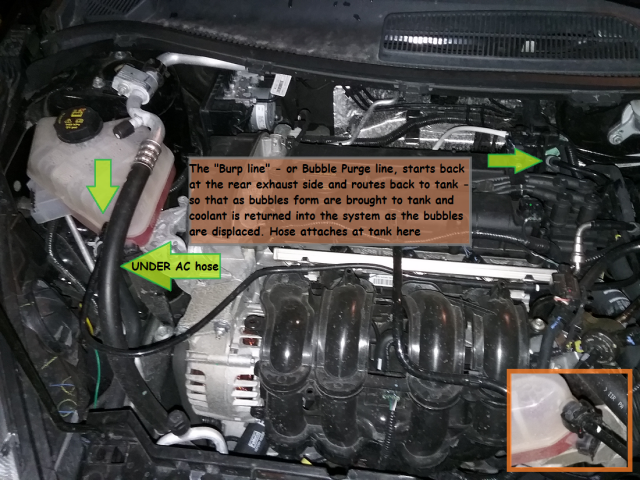
Don't try to drive too much on this engine - it looks to be pretty dry...
That hose is a means to keep coolant from the back - rear side of the motor from "boiling" and causing an air-pocket to form which can cause the heads to warp as well as other damage. That hose "burps" and allows coolant to circulate from that section of the motor back into the system and any air pockets to flow thru that line into the coolant recovery tank - ABOVE the shot of your yellow cap tank (Power Steering) in your photos. The "tank" is your high-spot for air bubbles in the system to purge into and coolant stays in the engine allowing for it to do it's job - circulating fluid and dissipating heat the engine makes into the cooling system.
The bubbles can form back there from a "slowing" of coolant back there - dead spot - so with all the circulating fluid, that area can stagnate and not be able to get enough turbulence to force the bubbles to break up and retun into the system to be bled off by other means back to that recovery tank. So it looks like they needed to install a line that "burps" the area back there to make sure fluid is kept in there and not an- otherwise insulating- air pocket possibly causing damage.
You can just fix it with some more hose but to do the job right requires you to use a semi-rigid line FORD used. That rigid pre-formed line is so the line won't kink or otherwise collapse if the pressures in the system towards the rear bank - fall - like in high-altitude and colder/sudden change to cold weather. It can create a vacuum trapping the air pocket back there and unable to force the displacement. Coolant has weight so the vacuum formed may pinch the line closed and keep the system from removing that air pocket.
Get that thing fixed there is a "nozzle" on the tank that goes to...
So to see that hose "cut off" like that makes me wonder if there was some intentional stuff going on.
Either way, you need to replace that line ASAP!
When you see a "white powder" coating - that is your coolant dried-up.
The broken hose looks to be a "Burp" (as I call it) hose that goes to the rear valve cover by the exhaust manifold.

Don't try to drive too much on this engine - it looks to be pretty dry...
That hose is a means to keep coolant from the back - rear side of the motor from "boiling" and causing an air-pocket to form which can cause the heads to warp as well as other damage. That hose "burps" and allows coolant to circulate from that section of the motor back into the system and any air pockets to flow thru that line into the coolant recovery tank - ABOVE the shot of your yellow cap tank (Power Steering) in your photos. The "tank" is your high-spot for air bubbles in the system to purge into and coolant stays in the engine allowing for it to do it's job - circulating fluid and dissipating heat the engine makes into the cooling system.
The bubbles can form back there from a "slowing" of coolant back there - dead spot - so with all the circulating fluid, that area can stagnate and not be able to get enough turbulence to force the bubbles to break up and retun into the system to be bled off by other means back to that recovery tank. So it looks like they needed to install a line that "burps" the area back there to make sure fluid is kept in there and not an- otherwise insulating- air pocket possibly causing damage.
You can just fix it with some more hose but to do the job right requires you to use a semi-rigid line FORD used. That rigid pre-formed line is so the line won't kink or otherwise collapse if the pressures in the system towards the rear bank - fall - like in high-altitude and colder/sudden change to cold weather. It can create a vacuum trapping the air pocket back there and unable to force the displacement. Coolant has weight so the vacuum formed may pinch the line closed and keep the system from removing that air pocket.
Get that thing fixed there is a "nozzle" on the tank that goes to...
So to see that hose "cut off" like that makes me wonder if there was some intentional stuff going on.
Either way, you need to replace that line ASAP!
Last edited:
- Messages
- 1,986
- Likes
- 1,385
- City
- Grand Rapids
- State
- MI
- Country
- United States
- What I Drive
- 2018 Ford Fiesta SE HB
I also realize that its a 2004 Ztec motor and what I've got is a Duratec motor - which are different but in 2004 they had used a "Tap" to a line that recirculated the radiator coolant to the front radiator - not the recovery tank - instead they "tapped" off the radiator BACK to the Recovery tank - which in a Duratec line of the Fiesta, they capped off the Radiator one - so what did they go? Well, they then took the overflow recovery overflow line and used that as their Purge line - you can see that in the research I did...
Examples...
So in the various model years, they tried to keep costs of re-tooling down - after all it was supposed to be the Loss-leader economy version ...
But to me this routing made more sense when I saw this...
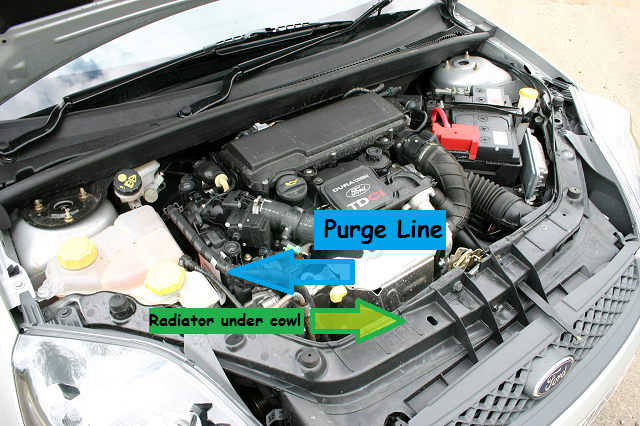
Note Power Steering And Radiator Coolant recovery tank
CAP COLORS are NEARLY the SAME - Sunny Yellow
- so you had to pay CLOSE attention to where to fill, and what to use
when it came to checking and replenishing
or topping off your fluid levels...
Even For The Experienced Techs!
One thing I'm concerned about though...

Ok, so where would that line go?
It is my belief that the Overflow hose, the one that trucks down in the photo - may need to be there, but the PURGE line needed to go to the Radiator.
How?
See the graphic below for ideas. I had to take a trip to a junk yard but all I could find was too smashed up to help. So I'm only offering - so IF YOU ARE NOT SURE CONSULT A DEALERSHIP TO HELP PROVIDE ASSISTANCE OR DIECTIONS ON HOW TO REPLACE THIS HOSE.
Ok, to keep it short, there were purge lines and extra "outlets" or "vents" for this - it also depended on where your vehicle was designed to be operated in a region for what purpose (passenger or Taxi - Self - Employed - business stuff) and - what country you reside in. So in one part of the world - you kept all hoses together and no Drain or overflow hose was available per that country or principalities dictated. So that meant you either replaced that hose to the tank - as you see tucking down in the above photo and the Purge Line went straight to it. Else the other method was to re route the purge line to the Radiator because it has a provision for the "burping" you needed - see below...
But then ...they provided an Air pocket relief system for the Radiator...
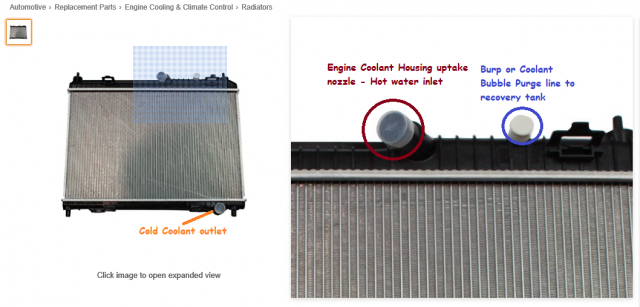
So you were provided at least a couple of places in which to purge air pockets that can form in engines that shared this chassis.
So as I did this project I came away with a better understanding of Fords' ability to adapt an engine to a chassis and a sadness or Loss as to see such an effort now closed off and they - Ford - has moved on to better and bigger things. - Fun to see the Evolution of this chassis. Just sorry to see it go.
Examples...
So in the various model years, they tried to keep costs of re-tooling down - after all it was supposed to be the Loss-leader economy version ...
But to me this routing made more sense when I saw this...

Note Power Steering And Radiator Coolant recovery tank
CAP COLORS are NEARLY the SAME - Sunny Yellow
- so you had to pay CLOSE attention to where to fill, and what to use
when it came to checking and replenishing
or topping off your fluid levels...
Even For The Experienced Techs!
One thing I'm concerned about though...

Ok, so where would that line go?
It is my belief that the Overflow hose, the one that trucks down in the photo - may need to be there, but the PURGE line needed to go to the Radiator.
How?
See the graphic below for ideas. I had to take a trip to a junk yard but all I could find was too smashed up to help. So I'm only offering - so IF YOU ARE NOT SURE CONSULT A DEALERSHIP TO HELP PROVIDE ASSISTANCE OR DIECTIONS ON HOW TO REPLACE THIS HOSE.
Ok, to keep it short, there were purge lines and extra "outlets" or "vents" for this - it also depended on where your vehicle was designed to be operated in a region for what purpose (passenger or Taxi - Self - Employed - business stuff) and - what country you reside in. So in one part of the world - you kept all hoses together and no Drain or overflow hose was available per that country or principalities dictated. So that meant you either replaced that hose to the tank - as you see tucking down in the above photo and the Purge Line went straight to it. Else the other method was to re route the purge line to the Radiator because it has a provision for the "burping" you needed - see below...
But then ...they provided an Air pocket relief system for the Radiator...

So you were provided at least a couple of places in which to purge air pockets that can form in engines that shared this chassis.
So as I did this project I came away with a better understanding of Fords' ability to adapt an engine to a chassis and a sadness or Loss as to see such an effort now closed off and they - Ford - has moved on to better and bigger things. - Fun to see the Evolution of this chassis. Just sorry to see it go.
Last edited:
- Messages
- 5
- Likes
- 1
- City
- Algiers
- State
- Non-US
- Country
- Algeria
- What I Drive
- Fiesta MK7.5
...
So in the various model years, they tried to keep costs of re-tooling down - after all it was supposed to be the Loss-leader economy version ...
But then ...they provided an Air pocket relief system for the Radiator...
So as I did this project I came away with a better understanding of Fords' ability to adapt an engine to a chassis and a sadness or Loss as to see such an effort now closed off and they - Ford - has moved on to better and bigger things. - Fun to see the Evolution of this chassis. Just sorry to see it go.
So in the various model years, they tried to keep costs of re-tooling down - after all it was supposed to be the Loss-leader economy version ...
But then ...they provided an Air pocket relief system for the Radiator...
View attachment 3840
So you were provided at least a couple of places in which to purge air pockets that can form in engines that shared this chassis.
So you were provided at least a couple of places in which to purge air pockets that can form in engines that shared this chassis.
So as I did this project I came away with a better understanding of Fords' ability to adapt an engine to a chassis and a sadness or Loss as to see such an effort now closed off and they - Ford - has moved on to better and bigger things. - Fun to see the Evolution of this chassis. Just sorry to see it go.
Do you suggest that i add the Purge pipe or just leave it as it is ?
Attachments
-
64.8 KB Views: 3
-
569.8 KB Views: 5
- Messages
- 1,986
- Likes
- 1,385
- City
- Grand Rapids
- State
- MI
- Country
- United States
- What I Drive
- 2018 Ford Fiesta SE HB
When your radiator "blew up" - what caused that condition? Either - a sudden failure or just old and due to an impact of debris - end result - the radiator leaks.
Sudden failures are related back to pressures within the system. It's a sealed system.
The "purge line" that comes with it, is usually adequate for it's lifetime. It just takes the air pockets it gets when the engine gets hot and the pressure of the coolant gets close to it's boiling point - and bleeds them off into the recovery tank - that's the line you have. If you follow it, it goes from the upper port on the tank, to the top of the exhaust side of the rear 4-cylinder on the cylinder head. People have taken that off, and they have that..."Hey! What's this?" moment There is small piece of plastic/metal to act like a bell - valve. It rests in a notch of that port and has the ability to move, letting air that would have stayed back there, to move out of the coolant and into and up thru that smaller line back out to the recovery tank
The Line I was referring to is on the radiator itself, it has a capped off port that is used for another purpose it once had. Which was similar to the bubble line you have now. The Tank itself also provided that port to take the bubbles that formed in the radiators' upper cap that they felt needed to have to return to the tank to remove the air pockets from that portion of the system.
Since you're changing it, you do not have any support from Ford for that port or the line it once had, unless you dig around in a wreck/junk yard for the older 2008 or so models that uses that "Ztech" engine that Focus and others also used. These designs also circulated fluid from the radiator using that hose all the time. They served to reduce air pockets, but forced a lot of heat from the engine out at the same time due to the unrestricted lines - bypassing the thermostat which helped keep the motor cool, but reduced the efficiency and for those in wither climates - anemically poor heating.
The Coolant tank also got way too hot for safety - so they removed the line and added in that bubble purge line to redice that circulation condition and let the air escape the motor.
So this may mean more of a another condition...
If you have a lot of miles on the motor - the cylinder head to engine block gasket - that seal may be breaking down.
IT starts out as some air that is trapped - bulges the tank, then if too much leaks past the gasket - it can burst the coolant tank and you can lose all your fluid. Ruining the motor - and your day.
The air this line would have - is from the combustion products that leak past the gasket and get into the coolant and the oil.
If left to itself for some time it collects that in the oil as a residue - you'll see a light colored "brown grease" that tells you you have coolant leaks into the oil - caused by the air, into the coolant, and this seeps into the oil - and due to the detergents in both systems, this forms that crud you see on the inside of your oil fill cap.
So, to me, I only mentioned that "History" because people have pulled off that cap and found out that they made a mess, this also can put you in a world of hurt for that port has a lot of hot fluid behind it - and when it worked - that pushed a lot of hot coolant back into the recovery tank making it a little too hot to handle.
Sudden failures are related back to pressures within the system. It's a sealed system.
The "purge line" that comes with it, is usually adequate for it's lifetime. It just takes the air pockets it gets when the engine gets hot and the pressure of the coolant gets close to it's boiling point - and bleeds them off into the recovery tank - that's the line you have. If you follow it, it goes from the upper port on the tank, to the top of the exhaust side of the rear 4-cylinder on the cylinder head. People have taken that off, and they have that..."Hey! What's this?" moment There is small piece of plastic/metal to act like a bell - valve. It rests in a notch of that port and has the ability to move, letting air that would have stayed back there, to move out of the coolant and into and up thru that smaller line back out to the recovery tank
The Line I was referring to is on the radiator itself, it has a capped off port that is used for another purpose it once had. Which was similar to the bubble line you have now. The Tank itself also provided that port to take the bubbles that formed in the radiators' upper cap that they felt needed to have to return to the tank to remove the air pockets from that portion of the system.
Since you're changing it, you do not have any support from Ford for that port or the line it once had, unless you dig around in a wreck/junk yard for the older 2008 or so models that uses that "Ztech" engine that Focus and others also used. These designs also circulated fluid from the radiator using that hose all the time. They served to reduce air pockets, but forced a lot of heat from the engine out at the same time due to the unrestricted lines - bypassing the thermostat which helped keep the motor cool, but reduced the efficiency and for those in wither climates - anemically poor heating.
The Coolant tank also got way too hot for safety - so they removed the line and added in that bubble purge line to redice that circulation condition and let the air escape the motor.
So this may mean more of a another condition...
If you have a lot of miles on the motor - the cylinder head to engine block gasket - that seal may be breaking down.
IT starts out as some air that is trapped - bulges the tank, then if too much leaks past the gasket - it can burst the coolant tank and you can lose all your fluid. Ruining the motor - and your day.
The air this line would have - is from the combustion products that leak past the gasket and get into the coolant and the oil.
If left to itself for some time it collects that in the oil as a residue - you'll see a light colored "brown grease" that tells you you have coolant leaks into the oil - caused by the air, into the coolant, and this seeps into the oil - and due to the detergents in both systems, this forms that crud you see on the inside of your oil fill cap.
So, to me, I only mentioned that "History" because people have pulled off that cap and found out that they made a mess, this also can put you in a world of hurt for that port has a lot of hot fluid behind it - and when it worked - that pushed a lot of hot coolant back into the recovery tank making it a little too hot to handle.
Last edited:
- Messages
- 5
- Likes
- 1
- City
- Algiers
- State
- Non-US
- Country
- Algeria
- What I Drive
- Fiesta MK7.5
When your radiator "blew up" - what caused that condition? Either - a sudden failure or just old and due to an impact of debris - end result - the radiator leaks.
Sudden failures are related back to pressures within the system. It's a sealed system.
The "purge line" that comes with it, is usually adequate for it's lifetime. It just takes the air pockets it gets when the engine gets hot and the pressure of the coolant gets close to it's boiling point - and bleeds them off into the recovery tank - that's the line you have. If you follow it, it goes from the upper port on the tank, to the top of the exhaust side of the rear 4-cylinder on the cylinder head. People have taken that off, and they have that..."Hey! What's this?" moment There is small piece of plastic/metal to act like a bell - valve. It rests in a notch of that port and has the ability to move, letting air that would have stayed back there, to move out of the coolant and into and up thru that smaller line back out to the recovery tank
The Line I was referring to is on the radiator itself, it has a capped off port that is used for another purpose it once had. Which was similar to the bubble line you have now. The Tank itself also provided that port to take the bubbles that formed in the radiators' upper cap that they felt needed to have to return to the tank to remove the air pockets from that portion of the system.
Since you're changing it, you do not have any support from Ford for that port or the line it once had, unless you dig around in a wreck/junk yard for the older 2008 or so models that uses that "Ztech" engine that Focus and others also used. These designs also circulated fluid from the radiator using that hose all the time. They served to reduce air pockets, but forced a lot of heat from the engine out at the same time due to the unrestricted lines - bypassing the thermostat which helped keep the motor cool, but reduced the efficiency and for those in wither climates - anemically poor heating.
The Coolant tank also got way too hot for safety - so they removed the line and added in that bubble purge line to redice that circulation condition and let the air escape the motor.
So this may mean more of a another condition...
If you have a lot of miles on the motor - the cylinder head to engine block gasket - that seal may be breaking down.
IT starts out as some air that is trapped - bulges the tank, then if too much leaks past the gasket - it can burst the coolant tank and you can lose all your fluid. Ruining the motor - and your day.
The air this line would have - is from the combustion products that leak past the gasket and get into the coolant and the oil.
If left to itself for some time it collects that in the oil as a residue - you'll see a light colored "brown grease" that tells you you have coolant leaks into the oil - caused by the air, into the coolant, and this seeps into the oil - and due to the detergents in both systems, this forms that crud you see on the inside of your oil fill cap.
So, to me, I only mentioned that "History" because people have pulled off that cap and found out that they made a mess, this also can put you in a world of hurt for that port has a lot of hot fluid behind it - and when it worked - that pushed a lot of hot coolant back into the recovery tank making it a little too hot to handle.
Sudden failures are related back to pressures within the system. It's a sealed system.
The "purge line" that comes with it, is usually adequate for it's lifetime. It just takes the air pockets it gets when the engine gets hot and the pressure of the coolant gets close to it's boiling point - and bleeds them off into the recovery tank - that's the line you have. If you follow it, it goes from the upper port on the tank, to the top of the exhaust side of the rear 4-cylinder on the cylinder head. People have taken that off, and they have that..."Hey! What's this?" moment There is small piece of plastic/metal to act like a bell - valve. It rests in a notch of that port and has the ability to move, letting air that would have stayed back there, to move out of the coolant and into and up thru that smaller line back out to the recovery tank
The Line I was referring to is on the radiator itself, it has a capped off port that is used for another purpose it once had. Which was similar to the bubble line you have now. The Tank itself also provided that port to take the bubbles that formed in the radiators' upper cap that they felt needed to have to return to the tank to remove the air pockets from that portion of the system.
Since you're changing it, you do not have any support from Ford for that port or the line it once had, unless you dig around in a wreck/junk yard for the older 2008 or so models that uses that "Ztech" engine that Focus and others also used. These designs also circulated fluid from the radiator using that hose all the time. They served to reduce air pockets, but forced a lot of heat from the engine out at the same time due to the unrestricted lines - bypassing the thermostat which helped keep the motor cool, but reduced the efficiency and for those in wither climates - anemically poor heating.
The Coolant tank also got way too hot for safety - so they removed the line and added in that bubble purge line to redice that circulation condition and let the air escape the motor.
So this may mean more of a another condition...
If you have a lot of miles on the motor - the cylinder head to engine block gasket - that seal may be breaking down.
IT starts out as some air that is trapped - bulges the tank, then if too much leaks past the gasket - it can burst the coolant tank and you can lose all your fluid. Ruining the motor - and your day.
The air this line would have - is from the combustion products that leak past the gasket and get into the coolant and the oil.
If left to itself for some time it collects that in the oil as a residue - you'll see a light colored "brown grease" that tells you you have coolant leaks into the oil - caused by the air, into the coolant, and this seeps into the oil - and due to the detergents in both systems, this forms that crud you see on the inside of your oil fill cap.
So, to me, I only mentioned that "History" because people have pulled off that cap and found out that they made a mess, this also can put you in a world of hurt for that port has a lot of hot fluid behind it - and when it worked - that pushed a lot of hot coolant back into the recovery tank making it a little too hot to handle.
I don't think it's a blown headgasket, i driven it for almost 200 miles and thankfully the oil is clean and the levels are good and the coolant is not boiling or bubbling also the temperature is same as always
and i also had a minor collision last year so it could be it and that very hot day just speed up the univetable.
And last year i replaced the Bottle's cap with one i bought from Ebay for 7 euros could this be the problem ?
And the Cap is 21psi is using one with a lower pressure help prevent another incident?
But the real concern is that the Radiator i just bought is not oem and if you were in my shoes would you add the Radiator-Tank pipe or not ?
Thank you.
- Messages
- 1,986
- Likes
- 1,385
- City
- Grand Rapids
- State
- MI
- Country
- United States
- What I Drive
- 2018 Ford Fiesta SE HB
This helps relate back to "If you were in my shoes" moment.
The issue of the collision can cause a simple shift in the radiators position - and have a rather larger effect on how the system can keep cool.
Follow me if you will...
The radiator...rests in a cradle, and if you notice, all the tubing and it's own "top" is STILL BELOW the Radiator recovery tank. This means that all those air pockets are supposed to rise up to the recovery tank - in some fashion or another. But the biggest impacts (pardon the pun) are the height of the engine to the tank - versus the height of the radiator to the tank.
If one is too high to the other, the bubbles of trapped air and gasses follows and rises and STAYS in the highest point of the system - they engineered it to want it to be the tank, not in the engine or the radiator - those air pockets can stall or hinder the flow of coolant in and thru the system so it can rescue portions of the engine that get hot.
To use a lesser pressure can help go a long way, but that is a stop gap measure - but it has helped many users get thru hotter days that the otherwise hotter engine and components on the hot day, would fail due to the extremely higher pressure soaring up as that coolant boils more readily because; in the exchange of heat to draw to the outside, it is not finding enough of a gradient in which to fulfill that promise. So the system just builds more pressure in it.
So to use a lower pressure cap, can help reduce the boiling pressure effect, but it will boil so this does not cure the problem of the heat that can't get pulled out of the motor on heavy hard drives in high temperature environments. The gasket will fail quicker due to the lower pressure and your required driving needs - if you don't let up on the gas, the engine will continue to produce higher pressures and temperatures and still boil - even more. Potentially leading to a blown gasket or even a warped cylinder head, because the gasket can't keep the pressure of combustion from one side from leaking - breaking thru to the other, being the water jacket and or the oil channels..
If you can follow that, let's talk...
The issue of the collision can cause a simple shift in the radiators position - and have a rather larger effect on how the system can keep cool.
Follow me if you will...
The radiator...rests in a cradle, and if you notice, all the tubing and it's own "top" is STILL BELOW the Radiator recovery tank. This means that all those air pockets are supposed to rise up to the recovery tank - in some fashion or another. But the biggest impacts (pardon the pun) are the height of the engine to the tank - versus the height of the radiator to the tank.
If one is too high to the other, the bubbles of trapped air and gasses follows and rises and STAYS in the highest point of the system - they engineered it to want it to be the tank, not in the engine or the radiator - those air pockets can stall or hinder the flow of coolant in and thru the system so it can rescue portions of the engine that get hot.
To use a lesser pressure can help go a long way, but that is a stop gap measure - but it has helped many users get thru hotter days that the otherwise hotter engine and components on the hot day, would fail due to the extremely higher pressure soaring up as that coolant boils more readily because; in the exchange of heat to draw to the outside, it is not finding enough of a gradient in which to fulfill that promise. So the system just builds more pressure in it.
So to use a lower pressure cap, can help reduce the boiling pressure effect, but it will boil so this does not cure the problem of the heat that can't get pulled out of the motor on heavy hard drives in high temperature environments. The gasket will fail quicker due to the lower pressure and your required driving needs - if you don't let up on the gas, the engine will continue to produce higher pressures and temperatures and still boil - even more. Potentially leading to a blown gasket or even a warped cylinder head, because the gasket can't keep the pressure of combustion from one side from leaking - breaking thru to the other, being the water jacket and or the oil channels..
If you can follow that, let's talk...
Last edited:
- Messages
- 5
- Likes
- 1
- City
- Algiers
- State
- Non-US
- Country
- Algeria
- What I Drive
- Fiesta MK7.5
If you can follow that, let's talk...
Yes id do understand this, every psi raises the boilling temperature by 3 dergrees
But i'm not worrying about overheating or boiling because i use G12+ Coolant and it's boiling temperature is higher than watter it's 135c and the pressure is 21psi so this means the boiling temperature is now 145c,
and even if used lower pressure cap, let's say 16psi, the boiling temperature will now be 133c and the highest temperature my car reached is 105c which is the temperature the Radiator fan kicks in first speed and stopps at 98c.
and you don't need a blown head gasked to overheat a small engine with a tiny Radiator like mine,
48 degrees c(118f) (The car showed 53c) or more can easily overwhelm the best cooling systems, especially in a heavy traffic like we have and also the climate changed dramaticaly and my car wasn't designed for such weather.
So i saw an online post and the guy had a Fiesta like mine and lived in an country where the climate in the summer is very hot, and he had a Duratec engine like mine, so in the winter every thing is fine ( The radiator fans turns at 105c and stopps at 98c and stays on for few seconds) but in the summer the coolant temperature easily rises to 115c so he added the pipe from the Radiator and connected it with the lower Tank valve and he says it never surpassed 105c again.
So to prevent possible future issues with the cooling system i wanted to ask if adding a pipe from the radiator to the lower tank valve (which my car doesn't have) will help and also i wanted to use a lower pressure cap to prevent the hoses from leaking or exploding because high presure is the first enemy of coolant hoses and if they get old and the weather gets hot, they start leaking very fast.
Attachments
-
2.2 MB Views: 3
- Messages
- 1,986
- Likes
- 1,385
- City
- Grand Rapids
- State
- MI
- Country
- United States
- What I Drive
- 2018 Ford Fiesta SE HB
Wow, good job on your research!
Although most of the cooling occurs in the jacket, the parts I was referring to are around areas that can't get coolant blowing by it all the time when the engine RPM is low. (stagnant coolant can boil because of hot-spotting at the area - it's why they put in that rear port on the cylinder head).
If you run a less pressure cap, this does not change the pressures of the combustion side - only the water jacket side.
This is not an easy reciprocal event, so to run the tube, no - not the best idea, for coolant would rush out of the radiator back into the tank unless you installed another bell valve at the port. It would act as a one way valve but gasses would escape.
I wish I had a phone to take pics of some of the wrecks I was fiddling around with to show you what I found that Ford and others did - one was that the coolant tank on some 2.0L and bigger systems used all those ports on the tank and went to not just the engine and water pump but the front port on the radiator - and a valve used with it.
So if the height of the radiator, engine and tank are still tiered - as in the tank is at the top - you can try to use that cap but it won't stop the gassing from getting blown by the head gasket - and eventually that can fail - heat is the problem - boiling seems to be taken care of, but the combustion side of the pressure does not change - only the jacket side and it would be less pressure pushing back on the gasket - leading to a fail in time - as to when? It depends on the severity of the demand and the pressure build up.
In order to remove the doubt of the pressures - you can use the 21psi - but use a 180 degree thermostat to keep the coolant flowing This reduces the pressure build by giving the fluid a gradient in both heat transfer and the pressure drop from the cooled coolant being denser - pulls down the build pressure. But the heavy acceleration still adds that complexity to the pressure condition, caused from the blow-by of the gasses into the coolant and oil passages and then the potential gasket failure, That can still happen - but then by using a low-temp thermostat - you get past the psi problems - but you need the 21psi to keep the pressure on the coolant side high enough to push back the combustion chambers' pressure when it's under load and demand. The sealing of the system is good to a point where the building of the gasses pressure are held -still- and are kept in the system for a long time - as in several months.
When you're done with the day of racing to get the job done, then you can pop the hood and unscrew the cap the few turns to reduce the pressure to release the gasses that will still be trapped in there the next time, day or whenever that demand is needed again - then retighten the cap to the stop to reset for another cycle. That process may be the only way around this - there is no provision, from Ford's way of doing things - to relieve the pressures as needed - they just stay in the system.
These things are a lot like pressure cookers, they use a valve to blow because the pressure to cook is needed to overcome the osmotic pressures the meal has to force the tenderization and finish cooking thoroughly - but you don't want the device to become shrapnel and projectiles because of some incident where you needed to get thru that part of your day.
Although most of the cooling occurs in the jacket, the parts I was referring to are around areas that can't get coolant blowing by it all the time when the engine RPM is low. (stagnant coolant can boil because of hot-spotting at the area - it's why they put in that rear port on the cylinder head).
If you run a less pressure cap, this does not change the pressures of the combustion side - only the water jacket side.
This is not an easy reciprocal event, so to run the tube, no - not the best idea, for coolant would rush out of the radiator back into the tank unless you installed another bell valve at the port. It would act as a one way valve but gasses would escape.
I wish I had a phone to take pics of some of the wrecks I was fiddling around with to show you what I found that Ford and others did - one was that the coolant tank on some 2.0L and bigger systems used all those ports on the tank and went to not just the engine and water pump but the front port on the radiator - and a valve used with it.
So if the height of the radiator, engine and tank are still tiered - as in the tank is at the top - you can try to use that cap but it won't stop the gassing from getting blown by the head gasket - and eventually that can fail - heat is the problem - boiling seems to be taken care of, but the combustion side of the pressure does not change - only the jacket side and it would be less pressure pushing back on the gasket - leading to a fail in time - as to when? It depends on the severity of the demand and the pressure build up.
In order to remove the doubt of the pressures - you can use the 21psi - but use a 180 degree thermostat to keep the coolant flowing This reduces the pressure build by giving the fluid a gradient in both heat transfer and the pressure drop from the cooled coolant being denser - pulls down the build pressure. But the heavy acceleration still adds that complexity to the pressure condition, caused from the blow-by of the gasses into the coolant and oil passages and then the potential gasket failure, That can still happen - but then by using a low-temp thermostat - you get past the psi problems - but you need the 21psi to keep the pressure on the coolant side high enough to push back the combustion chambers' pressure when it's under load and demand. The sealing of the system is good to a point where the building of the gasses pressure are held -still- and are kept in the system for a long time - as in several months.
When you're done with the day of racing to get the job done, then you can pop the hood and unscrew the cap the few turns to reduce the pressure to release the gasses that will still be trapped in there the next time, day or whenever that demand is needed again - then retighten the cap to the stop to reset for another cycle. That process may be the only way around this - there is no provision, from Ford's way of doing things - to relieve the pressures as needed - they just stay in the system.
These things are a lot like pressure cookers, they use a valve to blow because the pressure to cook is needed to overcome the osmotic pressures the meal has to force the tenderization and finish cooking thoroughly - but you don't want the device to become shrapnel and projectiles because of some incident where you needed to get thru that part of your day.
Last edited:
- Messages
- 5
- Likes
- 1
- City
- Algiers
- State
- Non-US
- Country
- Algeria
- What I Drive
- Fiesta MK7.5
but use a 180 degree thermostat to st
The thersmostat in all the European versions of the Fiesta with Duratec engine opens partially at 85°c(186f) and won't fully open until the coolant reach 98°c(208f), and when you drive in the highway the temperature rarely gets over 186f so this means the cool water from the radiator in entering the engine and there is enough airflow cooling it, but when stuck in traffic you have so little air and the temperature will keep rising until the Radiator fan finally start at 221°f and won't stop until the coolant cools to 208°f
So some people use a trick to make their engine run cooler, so when they're in heavy traffic they start the Ac, and then the Radiator fan stays on and help the coolant stay cooler, again because the Thermostat opens partially at 186f, but when it reached 122°f outside, i've seen brand new cars ovearheating especially German cars, because these cars were not designed for hot weather, and the cars exported to the middle east for example have bigger and more efficiant Radiators and better cooling systems overall otherwise it won't survive, unlike my Fiesta wich is designed for cooler weather
and when it gets as hot as 122°f in the summer, so when the coolant reach 221°f it's not very easy for the cooling system to cool it down in time because the Radiator is so small and the outisde air is hot and even if the fans are running full blast the coolant temperature will keep rising but if the radiator fan started at a lower temperature it would be easier and will take longer to reach a dangerous temperature.
So if Ford lowers the Fan starting temperature or allow us to change it with Forscan for example, let's say from 221°f to 194°f i know it will just delay the problem but still better, and the permanent solution is to replace the oem Radiator with a better one.
- Messages
- 1,986
- Likes
- 1,385
- City
- Grand Rapids
- State
- MI
- Country
- United States
- What I Drive
- 2018 Ford Fiesta SE HB
So if Ford lowers the Fan starting temperature or allow us to change it with Forscan for example, let's say from 221°f to 194°f i know it will just delay the problem but still better, and the permanent solution is to replace the oem Radiator with a better one
That makes two of us.
In earlier days, the "AC equipped" USA-made cars had 3-core (thicker) radiators as standard for the AC.- else most had only two core - and AC was "installed at the Factory" - many larger displacement ones used 4-core.
Nowdays, you'd be lucky if they put in two fans...which is not the problem, the exchange is what is needed - you only have so much surface area in which to dissipate the heat - as in Watts or Joules and it's ability to conduct the heat - conductivity in Watts per Kelvin.
Asks for a lot from a small surface area.
Liked how you put this in perspective - the issue though of the lower cap pressure does raise the caution of the system being able to withstand the combustion of one side to hold it back so it doesn't percolate thru the seals into the other systems. So we can't fix one condition without sacrificing the other.
The airflow opening was set up to make the engine more efficient in warm-ups - so I'll give them that. But to ignore the conditions of needed size or in some cases - shutters were offered. They used them for some models - to improve their efficiency. However, it puts the vehicles ability to withstand the hotter environment it is used in - like Arizona deserts - in one extreme. But others like Mountainous Cascades or Northern sections of Canada - you'd want the opposite. Too much heat is lost unless you block or slow the airflow, or reduce the size of the exchanger so you can keep the efficiency up..
Similar threads
-
-
P0340 and P0365 after water pump replacement
- Started by Spendoza
- Replies: 1
-
-
Estimated cost for timing belt and water pump replacement
- Started by Lee1985
- Replies: 2
-
-
-
Fitting a after market water temperature gauge
- Started by gizmo
- Replies: 0
-
2015 SE Trunk Water Leak?!
- Started by kjs_fiesta
- Replies: 7
-
Issues after water pump install
- Started by Thomp7721
- Replies: 2
-
2011 Ford Fiesta 1.4i Water Pump Change (Timing Belt change)
- Started by Ashlan
- Replies: 8

